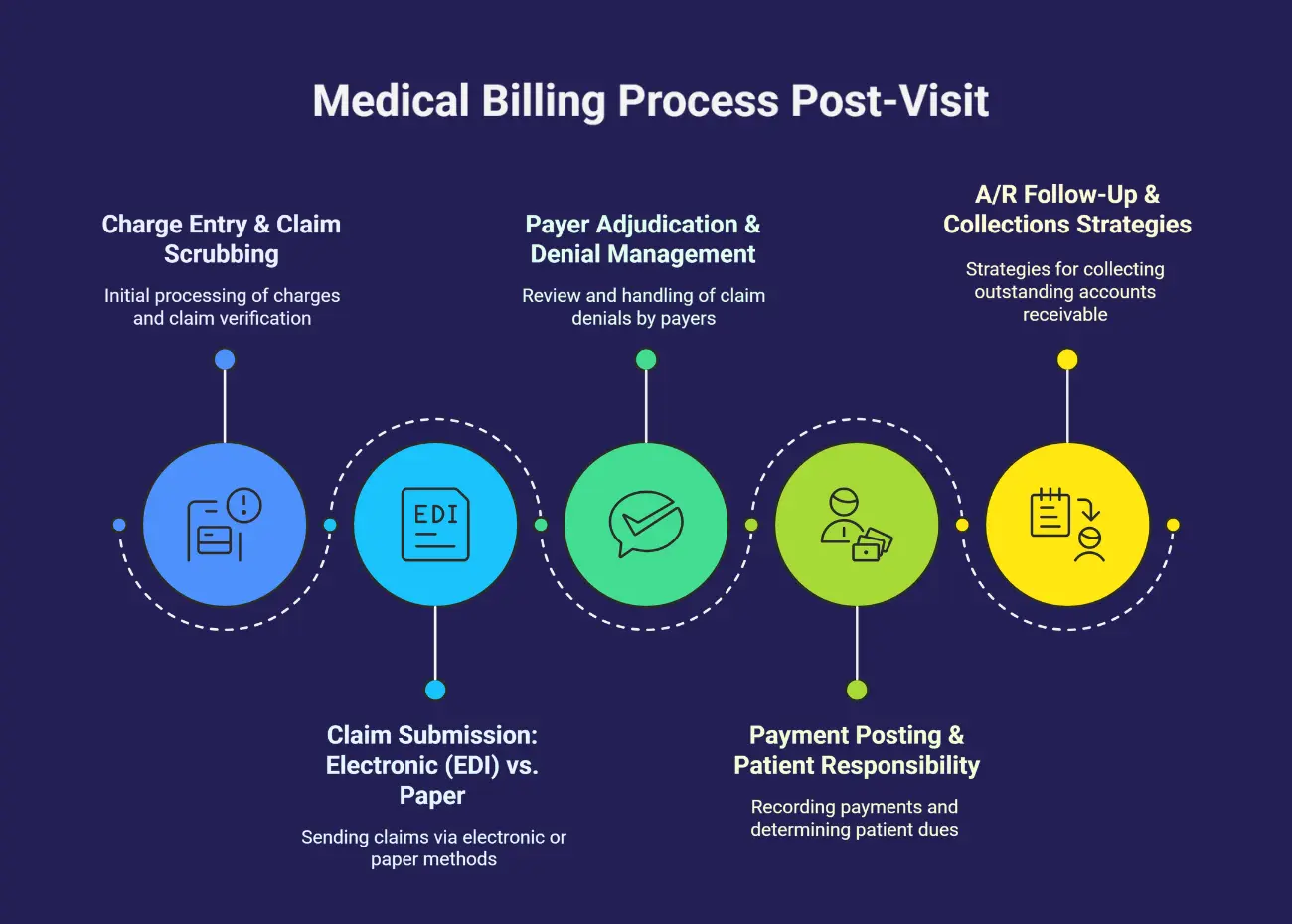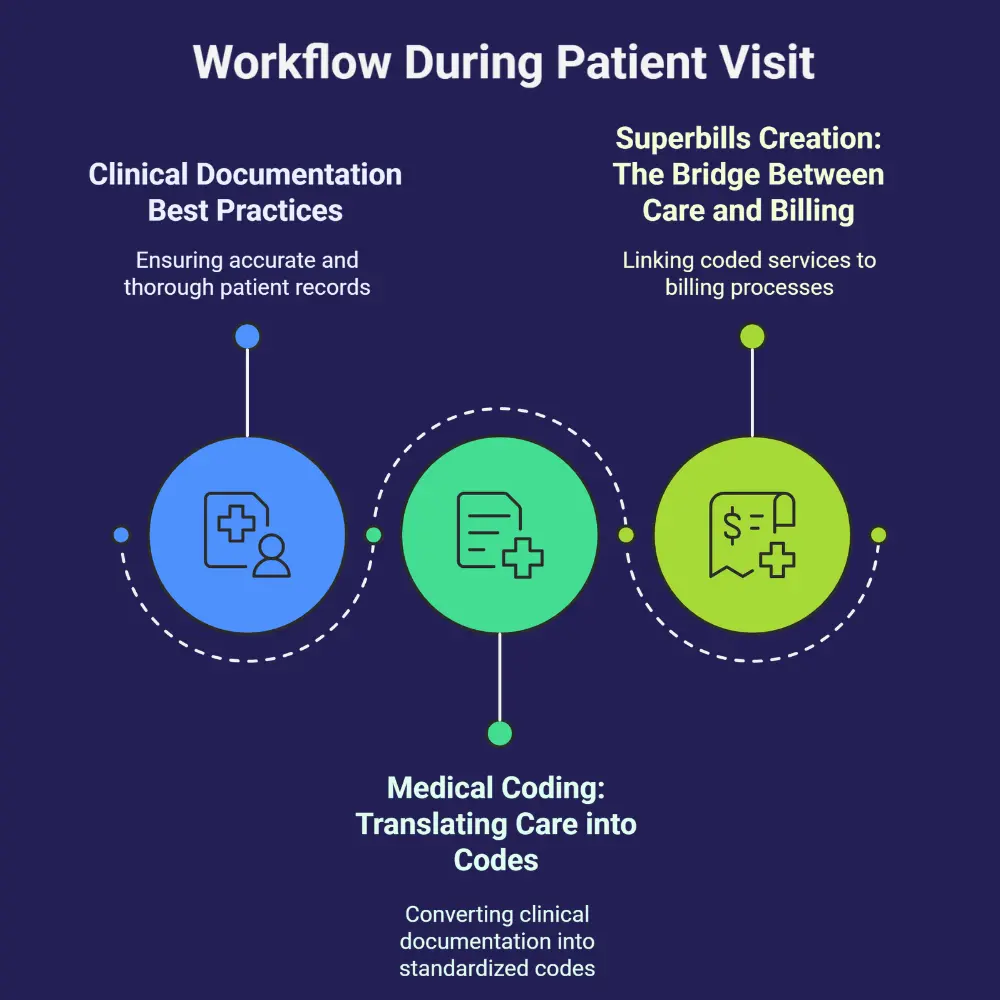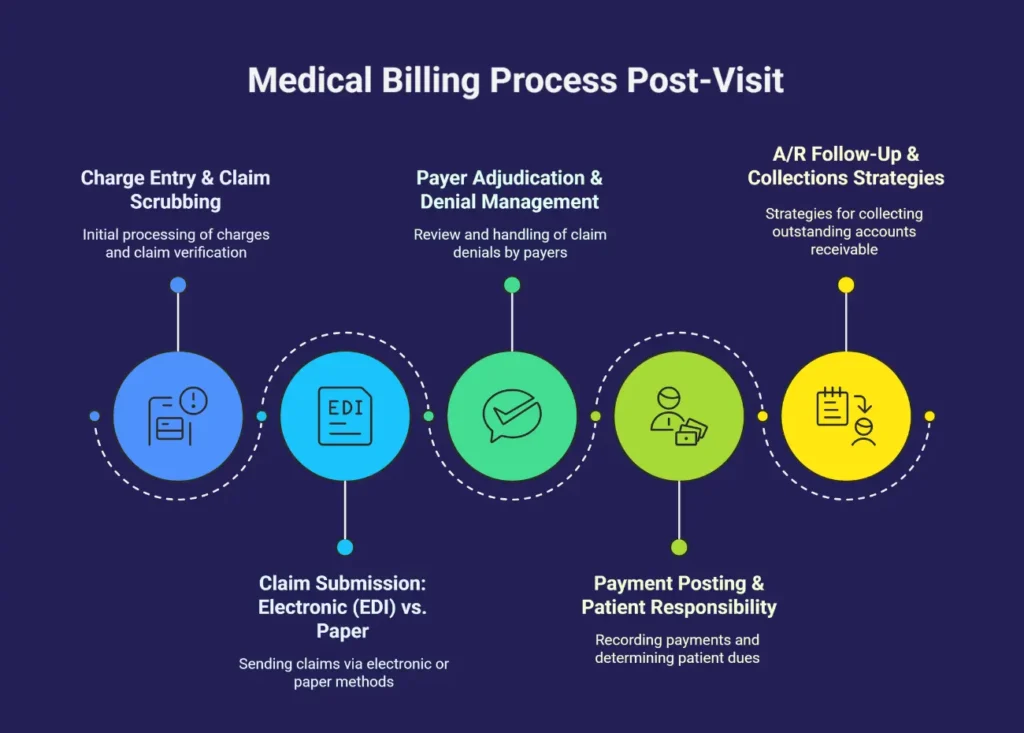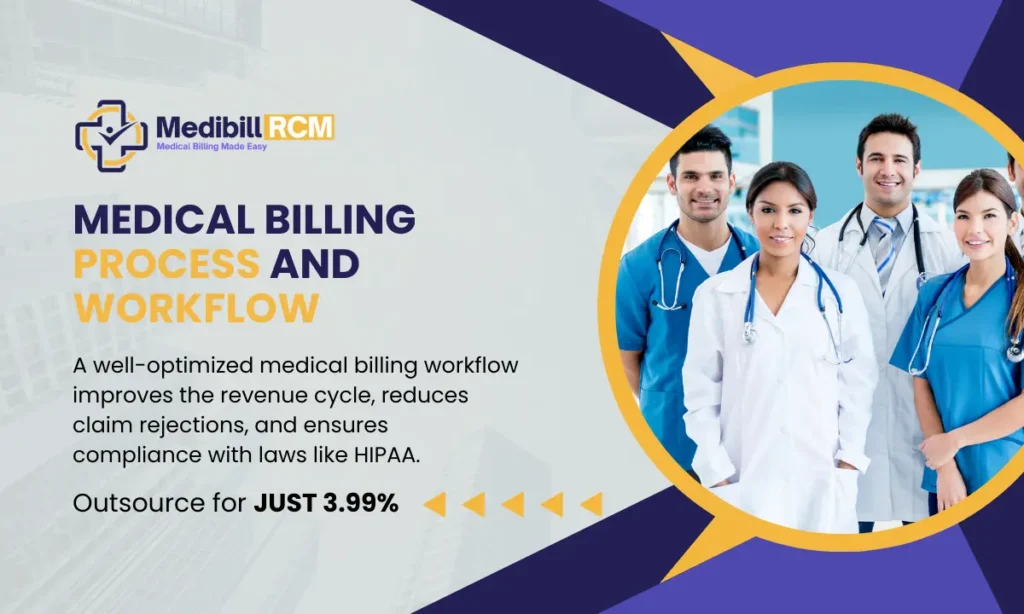Medical billing is a systematic process that helps healthcare providers get paid for their services. It includes key steps like:
- Registering patients
- Verifying insurance
- Assigning correct medical codes
- Submitting claims
- Posting payments
A well-optimized medical billing workflow improves the revenue cycle, reduces claim rejections, and ensures compliance with laws like HIPAA.
A well-optimized medical billing workflow improves revenue cycles and reduces denials—but achieving it alone is tough. Need help?
🚀 97% Claim Accuracy | 🚀 40% Faster Reimbursements | 🚀 Free Practice Audit
[Optimize My Billing Now →]“
Table of Contents
How Medical Billing Impacts Your Revenue Cycle?
A slow or disorganized billing process can delay payments, increase denials, and create compliance risks. On the other hand, an efficient workflow ensures:
✅ Faster Approvals – Fewer claim rejections due to accurate coding and documentation.
✅ Better Cash Flow – Shorter A/R cycles and faster reimbursements.
✅ Fewer Errors – Avoids mistakes like upcoding, down coding, or incorrect modifiers.
✅ Full Compliance – Meets HIPAA, CMS, and payer requirements.
A smooth medical billing process is key to maximizing revenue and keeping your practice financially healthy.
Essential Contributors to the Medical Billing Process
A smooth billing workflow depends on collaboration between these essential stakeholders:
| Role | Responsibilities |
|---|---|
| Healthcare Providers (Physicians, Nurses) | Accurately document patient encounters, treatments, and services provided |
| Medical Coders | Apply appropriate ICD-10, CPT, and HCPCS codes to diagnoses and procedures |
| Billing Specialists | Prepare and submit claims, manage reimbursement processes, and handle insurer follow-ups |
| Insurance Companies (Payers) | Evaluate claims, determine coverage eligibility, and process payments |
| Patients | Provide complete insurance information, pay copays/deductibles, and settle outstanding balances. |
Critical Impact: Each role directly influences claim accuracy, payment timelines, and revenue cycle performance. Errors at any stage may result in payment delays, claim denials, and potential revenue loss.
Download Medical Billing Process PDF
Related Post: Medical Billing Compliance Checklist
Phase 1: Pre-Visit Medical Billing Workflow
The pre-visit phase is crucial for ensuring claim accuracy and revenue cycle efficiency. Proper patient data collection, insurance verification, and prior authorization help prevent billing errors and claim denials.
1. Patient Registration: The First Step in the Medical Billing Process
Accurate patient registration is the foundation of a successful medical billing workflow. Errors in this stage can cause claim rejections and payment delays.
Key Registration Steps:
- Patient Demographics: Full name, date of birth, address, and contact information
- Insurance Verification: Policy number, group number, insurer name, and coverage details
- Digital Intake: Online forms minimize manual errors and streamline data collection
- Automated Validation: Real-time insurance eligibility checks through integrated tools
- Data Quality Control: Cross-verification to ensure accuracy of all collected information
Why It Matters
- Reduces claim rejections due to incorrect patient details.
- Speeds up eligibility verification and claim submission.
- Improves patient satisfaction by reducing billing conflict.
2. Insurance Verification: Ensuring Eligibility in the Workflow
Insurance verification confirms whether a patient’s health plan covers the services they will receive. Failure to verify can result in denied claims or unexpected patient costs.
Insurance Verification Process
- Real-Time Eligibility Checks: Verifies coverage using automated verification tools.
- Coverage Details: Confirms deductibles, copays, coinsurance, and policy limitations.
- Network Status: Identifies if the provider is in-network or out-of-network.
- Pre-existing Conditions & Exclusions: Ensures the procedure is covered.
Common Issues in Insurance Verification
| Issue | Impact | Solution |
|---|---|---|
| Expired Insurance | Claim rejection | Verify insurance before the visit |
| Incorrect Policy Details | Delayed reimbursement | Cross-check patient-provided info |
| Out-of-Network Provider | Higher patient costs | Notify patients in advance |
3. Pre-Authorization: Avoiding Denials in the Medical Billing Process
Specific procedures require prior authorization before they can be performed. This step ensures that the insurance company agrees to cover the service.
When is Pre-Authorization Required?
- Advanced Diagnostics: MRI, CT scans, PET scans
- Surgical Procedures: Both inpatient and outpatient surgeries
- Specialist Care: Referrals under managed care plans (e.g., HMOs)
- Specialty Medications: High-cost or non-formulary drugs
Pre-Authorization Workflow
- Submit a Request: Provider sends diagnosis, procedure codes, and medical necessity documentation.
- Payer Review: The insurance company evaluates the request based on coverage policies.
- Approval or Denial: If denied, the provider can submit an appeal with additional documentation.
How to Reduce Pre-Authorization Delays
- Use electronic prior authorization (ePA) tools.
- Verify requirements for each payer.
- Submit complete and accurate documentation.

Phase 2: Medical Billing Workflow During the Patient Visit
The medical billing process continues during the patient visit. Accurate documentation and coding are crucial for claim approval and timely reimbursement. Mistakes at this stage can result in claim denials, compliance issues, and lost revenue.
4. Clinical Documentation: Backbone of the Medical Billing Process
Clinical documentation records patient visits, diagnoses, and treatments. Thus forming the basis for accurate coding and successful claims.
Key Components of Clinical Documentation
- EHR Integration: Provides instant access to patient data for seamless billing.
- SOAP Notes: A structured format (Subjective, Objective, Assessment, Plan) for precise documentation.
- Avoiding Gaps: Incomplete or unclear details can lead to claim denials.
Best Practices for Error-Free Documentation
- Use EHR Templates: Reduces manual errors and improves consistency.
- Document Thoroughly: Include all diagnoses, procedures, and provider notes.
- Maintain Compliance: Follow CMS and HIPAA rules to prevent audits and penalties.
5. Medical Coding: The Heart of the Billing Workflow
Medical coding converts clinical notes into standardized codes for accurate billing and insurance claims.
Key Coding Systems
| System | Purpose | Example |
|---|---|---|
| ICD-10-CM | Diagnoses | Diabetes: E11.9 |
| CPT | Procedures | Office visit: 99213 |
| HCPCS Level II | Supplies, drugs, & non-MD services | Ambulance transport: A0425 |
Avoiding Costly Coding Errors
- Upcoding (Billing for a higher service than provided) → Risk: Fraud fines.
- Downcoding (Billing for a lower service) → Risk: Lost revenue.
- Unbundling (Splitting bundled services) → Risk: Denied claims.
✅ Solution: Regular coding audits, AI-powered coding tools, and ongoing staff training.
6. Superbill Creation: Bridging Care and the Billing Process
A superbill is a detailed invoice that captures all services provided during a patient visit. It serves as the foundation for claim generation.
Key Components of a Superbill
- Provider Info: Name, NPI number, specialty
- Patient Details: Name, DOB, insurance ID
- Services Rendered: ICD-10/CPT codes (with modifiers)
- Validation Requirements: Service date & provider signature
Why Superbills Matter
- Minimizes coding mistakes and claim disputes
- Guarantees proper reimbursement matching documentation
- Bridges clinical care and revenue cycle efficiency

Phase 3: Post-Visit Medical Billing Workflow
The post-visit phase ensures that claims are processed correctly, payments are received, and outstanding balances are managed efficiently. A structured approach to claim scrubbing, submission, adjudication, and payment posting prevents revenue loss and compliance issues.
7. Charge Entry & Claim Scrubbing: Streamlining the Billing Process
Charge Entry converts medical services into billable claims, while Claim Scrubbing detects and corrects errors before submission.
Key Steps in Charge Entry
- Assign ICD-10, CPT, and HCPCS codes based on documentation.
- Apply modifiers when needed for precise billing.
- Verify units of service to ensure accurate charges.
Claim Scrubbing: Catching Errors Early
Automated scrubbers flag issues like:
- NPI/Taxonomy Errors (Wrong provider details)
- Coding Mistakes (Upcoding, down coding, or missing codes)
- Payer-Specific Rule Violations (Insurers have unique requirements)
✅ Best Practice: Use AI-powered claim scrubbers + manual audits before submission.
8. Claim Submission: Electronic (EDI) vs. Paper in the Workflow
Once the claim is scrubbed, it is submitted to the payer via electronic data interchange (EDI) or paper forms.
Claim Submission Methods
| Submission Type | Use Case | Forms Used |
|---|---|---|
| Electronic (EDI) | Faster processing, lower rejection rates | 837P (Professional) / 837I (Institutional) |
| Paper Submission | Used if payers don’t accept EDI | CMS-1500 (Physicians) / UB-04 (Hospitals) |
✅ Tip: Most payers prefer EDI for faster reimbursements and fewer errors.
For a complete breakdown of modern submission methods, see our Medical Claims Processing Guide covering everything from clearinghouses to direct payer APIs.
9. Payer Adjudication: Decoding the Medical Billing Process
Payers review submitted claims through adjudication, where they approve, deny, or adjust payments.
Key Steps in Payer Adjudication
1. Initial Review: Checks for eligibility, correct coding, and service necessity.
2. Claim Decision:
- Accepted: Approved for payment.
- Denied: Requires correction and resubmission.
- Reduced Payment: Adjusted based on policy coverage.
3. Explanation of Benefits (EOB) or Electronic Remittance Advice (ERA): Details claim decisions.
Common Claim Denial Reasons
- Missing Modifiers – Required procedure details not included
- Lack of Medical Necessity – Service not covered under policy guidelines
- Duplicate Claims – The same claim submitted multiple times
✅ Solution: Implement denial management strategies to appeal and correct errors.
Payers may deny AOB claims if the agreement isn’t properly documented. Learn how to avoid this in our AOB Legal Insights guide.
10. Payment Posting: Finalizing the Workflow
Once adjudication is complete, payments are posted to patient accounts and financial records.
Steps in Payment Posting
- ERA/EOB Reconciliation: Matches payer payments with billed charges.
- Patient Statements: Sends bills for any remaining balance.
- Adjustments & Write-Offs: Handles contractual reductions or uncollectible amounts.
✅ Tip: Automate payment posting to improve cash flow and financial accuracy.
11. A/R Follow-Up: Closing Gaps in the Medical Billing Process
Accounts Receivable (A/R) follow-up ensures outstanding balances are collected efficiently.
A/R Management Best Practices
- Aging Reports: Track unpaid claims over 30, 60, and 90+ days.
- Ethical Collections: Offer payment plans, financial counseling, and digital payment options.
- Bad Debt Management: Write off balances when collections are no longer feasible.
✅ Strategy: Use automated A/R tracking and proactive patient communication to reduce outstanding balances.
See how revenue cycle management extends the billing process for full-cycle control.

“Incorrect coding costs practices $100K+ yearly.”
“Our certified coders ensure 99% accuracy. No more lost revenue.
[Audit My Coding →]“
Optimizing the Medical Billing Workflow: Challenges & Solutions
Optimizing the medical billing process boosts revenue cycle efficiency, cuts down on claim denials, and ensures compliance with healthcare rules. Key challenges include denied claims, regulatory hurdles, and difficulties collecting patient payments. Solving these problems improves cash flow and reduces financial risks.
Reducing Denials: Streamlining the Medical Billing Process
Claim denials delay payments and increase administrative costs. Identifying and correcting denial causes improves reimbursement rates.
Top Denial Reasons & Solutions
| Denial Reason | Cause | Solution |
|---|---|---|
| Eligibility Issues | Expired insurance, coverage limitations | Real-time insurance verification before the visit |
| Incorrect Coding | Missing modifiers, upcoding/downcoding | Conduct coding audits and use AI-driven coding tools |
| Medical Necessity Denials | Insufficient documentation | Ensure comprehensive clinical notes support billed services |
| Duplicate Claims | Resubmission errors | Implement automated claim tracking |
| Late Submission | Filed after payer’s deadline | Track timely filing windows for each insurer. |
✅ Best Practice: Use denial management software to analyze trends and prevent repeat errors.
Tracking denials by category helps improve your PC Ratio by identifying which procedures have the worst collection rates.
Compliance in the Medical Billing Workflow: HIPAA & Audits
Regulatory compliance helps avoid legal risks, audits, and fines. In medical billing, HIPAA requires strict protection of patient data.
Key Compliance Challenges & Solutions
HIPAA Violations
- Risk: Unauthorized access to patient data.
- Fix: Encrypt sensitive data + restrict access with role-based controls.
Coding Errors
- Risk: Mistakes in ICD-10, CPT, or HCPCS codes.
- Fix: Regular staff training on the latest billing rules.
Audit Failures
- Risk: Missing or incomplete records.
- Fix: Use EHR-integrated templates to ensure audit-proof documentation.
✅ Solution: Conduct routine compliance audits and align staff training with CMS & payer updates to stay ahead.
Patient Payment Barriers: Fixing Workflow Leaks
Patients face financial obstacles that can lead to payment delays and bad debt. Improving payment accessibility increases collections and patient satisfaction.
Common Payment Barriers & Fixes
| Barrier | Impact | Solution |
|---|---|---|
| High Out-of-Pocket Costs | Patients delay or avoid payments | Offer flexible payment plans |
| Confusing Billing Statements | Increases disputes and delays | Provide clear, itemized bills |
| Limited Payment Options | Reduces payment completion rates | Implement online portals & digital payments |
✅ Strategy: Use automated reminders and patient education to improve payment compliance.
Technology’s Role in the Modern Medical Billing Process
Technology streamlines the medical billing process, minimizes human error, and increases revenue cycle efficiency. AI tools, EHR systems, and telehealth-specific protocols help providers meet evolving payer requirements while maintaining billing accuracy and compliance.
AI in Medical Billing: Automating the Workflow
Artificial Intelligence (AI) improves billing speed and accuracy by analyzing large datasets and predicting claim outcomes.
How AI Enhances Medical Billing
- Predictive Analytics: Identifies claims at high risk for denial before submission.
- Automated Coding: Assigns accurate ICD-10 and CPT codes using NLP.
- Denial Prevention: Flags documentation gaps and inconsistent coding patterns.
✅ Impact: AI reduces administrative workload, improves first-pass claim acceptance rates, and accelerates revenue recovery.
EHR Integration: Smoothing the Billing Workflow
EHR systems integrate clinical and billing data, reducing redundancy and manual entry.
Key Benefits of EHR Integration
- Reduces Duplicate Data Entry: Syncs patient demographics, insurance, and service details.
- Improves Claim Accuracy: Automatically transfers coded services to billing.
- Supports Audit Readiness: Maintains timestamped, structured documentation.
✅ Result: Fewer claim denials, better provider coordination, and stronger compliance with payer rules.
Telehealth Billing: Adapting the Process for Virtual Care
Telehealth requires specific billing practices due to payer variability and coding requirements.
Important Billing Considerations for Telehealth
Use of Modifiers:
- GT = Synchronous telemedicine via interactive audio and video.
- 95 = Telehealth services delivered with real-time interaction.
Payer-Specific Policies:
- Coverage varies by state, provider type, and visit purpose.
- Some payers require place of service code “02” or “10”.
✅ Solution: Keep current with CMS guidelines, payer bulletins, and telehealth coding updates.
FAQs: Medical Billing Process and Workflow
How long does the medical billing process take?
Clean claims (error-free submissions) typically take 14–30 days from submission to payment. Denied claims, however, can extend to 60+ days due to corrections, resubmission, and appeals. To minimize delays, use electronic claim submissions, verify insurance upfront, and ensure coding accuracy.
In-house vs. outsourced medical billing: Which is better?
In-house billing offers more control but requires investment in software, staff training, and dedicated personnel, ideal for small clinics with limited billing volume. Outsourcing reduces administrative workload, provides specialized expertise, and scales efficiently for high-volume or multi-location practices. The decision hinges on cost, internal resources, and workflow complexity.
What’s the difference between medical billing and coding?
Medical coding translates diagnoses and procedures into standardized codes (ICD-10, CPT, HCPCS) for claims. Medical billing uses these codes to submit, track, and follow up on insurance claims and patient payments. Coders focus on clinical data accuracy; billers handle reimbursement workflows.
How can I improve my medical billing process?
Key strategies include:
1. Verifying insurance eligibility in real-time,
2. Using automated claim scrubbers to reduce errors,
3. Training staff on compliance updates,
4. Tracking and analyzing denial patterns,
5. Integrating EHRs, AI tools, and patient payment portals for efficiency.
6. Regular audits and performance reviews ensure sustained improvements.
What are the 10 steps in the medical billing process?
1. Patient registration (collecting demographics/insurance).
2. Insurance verification (confirming coverage).
3. Pre-authorization (for specific services).
4. Clinical documentation (recording diagnoses/treatments).
5. Medical coding (assigning ICD-10, CPT, or HCPCS codes).
6. Charge entry (linking codes to billing systems).
7. Claim scrubbing (error-checking before submission).
8. Claim submission (sending to payers electronically/paper).
9. Payer adjudication (insurer’s approval/denial).
10. Payment posting & A/R follow-up (reconciling payments/appealing denials).
MediBill RCM LLC: Optimizing Revenue Cycle Management for Healthcare Providers
MediBill RCM LLC provides comprehensive medical billing solutions designed to streamline workflows, enhance claim accuracy, and maximize reimbursements. Our end-to-end revenue cycle management ensures precision at every stage – from patient intake to final payment collection.
Complete Revenue Cycle Management Services
Our full-spectrum solution includes:
- Provider credentialing to ensure proper payer enrollment and reduce processing delays
- Certified coding specialists maintaining strict ICD-10, CPT, and HCPCS compliance
- Advanced denial management systems that track, analyze, and resolve claim rejections
- Continuous performance monitoring to prevent recurring errors and improve recovery rates
Proven Results: 40% Reduction in Claim Denials
A Texas cardiology practice achieved remarkable improvements through our partnership:
✅ 40% decrease in claim denials within 90 days
✅ 25% reduction in accounts receivable days
✅ Significant improvement in clean claim rates
These results were achieved through our implementation of:
- Real-time insurance eligibility verification
- EHR-integrated documentation review systems
- Automated denial tracking and resolution protocols
“Want similar results?
📈 40% Fewer Denials | 📈 25% Faster A/R | 📈 Free Custom Plan
[Get My Free Practice Assessment]“
Complimentary Practice Assessment
MediBill RCM LLC offers a free medical billing workflow audit to help practices:
• Identify revenue leakage points
• Pinpoint denial patterns and root causes
• Uncover compliance vulnerabilities
• Receive customized optimization recommendations
Our audit provides actionable insights across all billing phases, from patient registration through payment posting, helping you build a more efficient and profitable revenue cycle.
Related Posts
- What is Medical Billing Outsourcing? Benefits, Challenges & How to Choose the Best Provider
- Rendering Provider vs Billing Provider: Key Differences, Compliance Strategies
- How to Choose the Right Medical Billing Company for Your Practice in 2025?
- Top 10 Best Medical Billing and Coding Companies in Texas 2025


